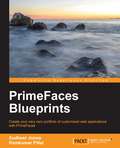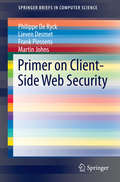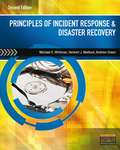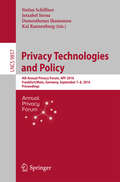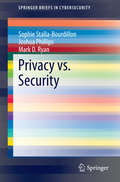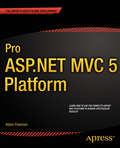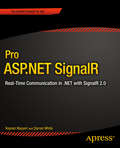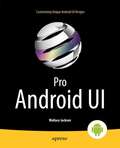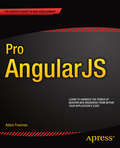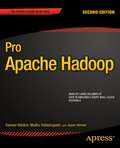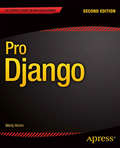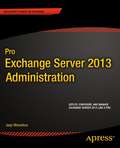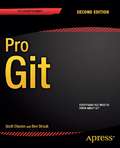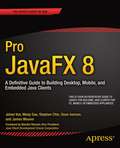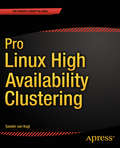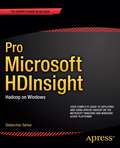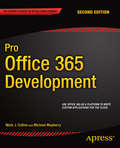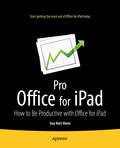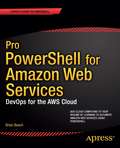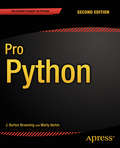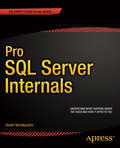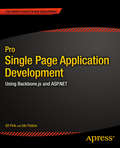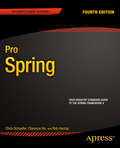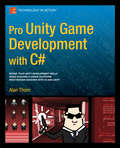- Table View
- List View
PrimeFaces Blueprints
by Sudheer Jonna Ramkumar PillaiIf you are a Java developer with experience of frontend UI development, and want to take the plunge to develop stunning UI applications with the most popular JSF framework, PrimeFaces, then this book is for you. For those with entrepreneurial aspirations, this book will provide valuable insights into how to utilize successful business models.
Primer on Client-Side Web Security
by Philippe De Ryck Lieven Desmet Frank Piessens Martin JohnsThis volume illustrates the continuous arms race between attackers and defenders of the Web ecosystem by discussing a wide variety of attacks. In the first part of the book, the foundation of the Web ecosystem is briefly recapped and discussed. Based on this model, the assets of the Web ecosystem are identified, and the set of capabilities an attacker may have are enumerated. In the second part, an overview of the web security vulnerability landscape is constructed. Included are selections of the most representative attack techniques reported in great detail. In addition to descriptions of the most common mitigation techniques, this primer also surveys the research and standardization activities related to each of the attack techniques, and gives insights into the prevalence of those very attacks. Moreover, the book provides practitioners a set of best practices to gradually improve the security of their web-enabled services. Primer on Client-Side Web Security expresses insights into the future of web application security. It points out the challenges of securing the Web platform, opportunities for future research, and trends toward improving Web security.
Principles Of Incident Response And Disaster Recovery
by Andrew Green Michael Whitman Herbert MattordPrinciples Of Incident Response And Disaster Recovery, 2nd Edition presents methods to identify vulnerabilities within computer networks and the countermeasures that mitigate risks and damage. From market-leading content on contingency planning, to effective techniques that minimize downtime in an emergency, to curbing losses after a breach, this text is the resource needed in case of a network intrusion.
Principles of Wireless Sensor Networks
by Sudip Misra Mohammad S. ObaidatWireless sensor networks are an emerging technology with a wide range of applications in military and civilian domains. The book begins by detailing the basic principles and concepts of wireless sensor networks, including information gathering, energy management and the structure of sensory nodes. It proceeds to examine advanced topics, covering localisation, topology, security and evaluation of wireless sensor networks, highlighting international research being carried out in this area. Finally, it features numerous examples of applications of this technology to a range of domains, such as wireless, multimedia, underwater and underground wireless sensor networks. The concise but clear presentation of the important principles, techniques and applications of wireless sensor networks makes this guide an excellent introduction for anyone new to the subject, as well as an ideal reference for practitioners and researchers.
Privacy Technologies and Policy
by Demosthenes Ikonomou Stefan Schiffner Jetzabel Serna Kai RannenbergThis book constitutes the refereed proceedings of the Second Annual Privacy Forum, APF 2014, held in Athens, Greece, in May 2014. The 12 revised papers presented in this volume were carefully reviewed and selected from 21 submissions. The topics include: the concept and implementation of "privacy by design", with applications to encrypted databases; the study of video surveillance architectures and new networking concepts and innovative solutions for identity management. The papers address the technical, legal, and economic aspects of these problems.
Privacy vs. Security
by Sophie Stalla-Bourdillon Joshua Phillips Mark D. RyanSecuring privacy in the current environment is one of the great challenges of today's democracies. Privacy vs. Security explores the issues of privacy and security and their complicated interplay, from a legal and a technical point of view. Sophie Stalla-Bourdillon provides a thorough account of the legal underpinnings of the European approach to privacy and examines their implementation through privacy, data protection and data retention laws. Joshua Philips and Mark D. Ryan focus on the technological aspects of privacy, in particular, on today's attacks on privacy by the simple use of today's technology, like web services and e-payment technologies and by State-level surveillance activities.
Pro ASP.NET MVC 5 Platform
by Adam FreemanThe power of ASP. NET MVC 5 stems from the underlying ASP. NET platform. To make your ASP. NET MVC applications the best they can be, you need to fully understand the platform features and know how they can be used to build effective and elegant MVC framework applications. The ASP. NET platform provides ASP. NET MVC applications with a rich suite of services including vital every-day features like extensible request handling, state management, and user authentication. Understanding how these features work is the difference between creating an average web application and the best-in-class. MVC applications that are architected with a thorough knowledge of the underlying platforms are faster to write, faster to run, and more readily adaptable to change. In Pro ASP. NET MVC 5 Platform, best-selling author Adam Freeman explains how to get the most from the entire ASP. NET platform, beginning with a nuts-and-bolts description of the patterns and tools you need through to the most advanced features. He goes in-depth at every stage to give you the practical knowledge that you need to apply these concepts to your own code. What you'll learn Understand how ASP. NET MVC 5 is built on the ASP. NET platform. Create scalable MVC framework web applications that work in harmony with the underlying platform Understand the ASP. NET Lifecycle and how it affects the whole ASP. NET stack Extend and Customize the ASP. NET platform to suit your MVC5 web application Who this book is for The book is ideal for anyone wanting to use ASP. NET MVC 5 in a professional context. It works particularly well as a compliment to Adam Freeman's other ASP. NET MVC titles Pro ASP. NET MVC 5, Pro ASP. NET MVC 5 Client, and Expert ASP. NET Web API 2 for MVC Developers. Table of Contents Part 1. Getting Ready 1. Putting the ASP. NET Platform in Context 2. Patterns and Tools Primer Part 2. The ASP. NET Platform Foundation 3. The ASP. NET Lifecycles 4. Modules 5. Handlers 6. Disrupting the Request Lifecycle 7. Detecting Device Capabilities 8. Tracing Requests Part 3. The ASP. NET Services 9. Configuration 10. State Data 11. Caching Data 12. Caching Content 13. Get Started with ASP. NET Identity 14. Applying ASP. NET Identity 15. Advanced ASP. NET Identity"
Pro ASP.NET SignalR
by Keyvan Nayyeri Darren WhiteASP. NET SignalR is the new solution to real-time communication between servers and clients in . NET. Use it to push new data to a web page or mobile device as soon as it becomes available, whether it's a notification, live chat, up-to-the-minute financial data, or a range of other exciting applications. Innovations like Google live search and live Facebook and Twitter updates are pushing users' expectations of the real-time web. With Pro ASP. NET SignalR, you can join this revolution and learn skills that will be valuable for years to come. Pro ASP. NET SignalR starts with an introduction to the real-time web. Learn about the technologies underlying the SignalR library, such as WebSockets and long-polling, and how SignalR elegantly flips between them depending on the capabilities of the client. Next, meet the concepts of hubs and persistent connections and how to use them to build the components of an ASP. NET SignalR application. Find out how to extend, test, debug, configure, scale, and host your applications, and how to target a range of clients, including Windows and iOS. The book rounds off with two case studies--a stock market price updater, and a collaborative drawing application--so you can get to grips with SignalR in a realistic scenario, using a broad range of the concepts covered in earlier chapters. As real-time updates to web and mobile apps become the norm, Pro ASP. NET SignalR will be your in-depth, one-stop companion to this new and exciting technology.
Pro Android UI
by Wallace JacksonIf you''re an Android application developer, chances are you''re using fixed, scrolling, swipe-able, and other cutting-edge custom UI Designs in your Android development projects. These UI Design approaches as well as other Android ViewGroup UI layout containers are the bread and butter of Pro Android User Interface (UI) design and Android User Experience (UX) design and development. Using a top down approach, Pro Android UI shows you how to design and develop the best user interface for your app, while taking into account the varying device form factors in the increasingly fragmented Android environment. Pro Android UI aims to be the ultimate reference and customization cookbook for your Android UI Design, and as such will be useful to experienced developers as well as beginners. With Android''s powerful UI layout classes, you can easily create everything from the simplest of lists to fully tricked-out user interfaces. While using these UI classes for boring, standard user interfaces can be quite simple, customizing a unique UI design can often become extremely challenging. What you''ll learn How to design and develop a sleek looking and highly functional user interface (UI) design and experience (UX) design using Android APIs What Android layout containers are, and how to best leverage them How to design user-friendly UI layouts that conform to Android UI guidelines What, when, why and how to use fundamental Android UI layout containers (ViewGroup subclasses) and Android UI widgets (View subclasses) How to use new media assets such as images, video, and animation in a UI How to create UI Fragments for UI design for specific ActionBar or Activity classes that you wish to create for UI designs within your applications Scaling UI Design for the various Android smartphone and tablet form factors Who this book is for This book is for experienced Android app developers. It can also be for app developers and UI designers working on other platforms like iOS and BlackBerry who might also be interested in Android. Table of Contents Part I. Introduction to the Core Classes for Android UI Design: Development Tools, Layout Containers and Widgets 1. Android UI Design Tools: Setting Up Your Android Development System 2. Android UI Layouts: Layout Containers and the ViewGroup Class 3. Android UI Widgets: User Interface Widgets and the View Class Part II. Introduction to Android Menu Class for UI Design: OptionsMenu, ContextMenu, PopupMenu and ActionBar 4. Android UI Options Menus: OptionsMenu Class and an Introduction to the Android ActionBar 5. Android UI Local Menus: The ContextMenu Class and PopupMenu Class 6. Android UI Action Bar: Advanced ActionBar Design & ActionBar Class Part III. Android UI: Layout Considerations, Concepts & UI Containers: LinearLayout, RelativeLayout, FrameLayout 7. Android UI Design Considerations: Styles, Screen Density Targets and New Media Formats 8. Android UI Design Concepts: Wire-framing & UI Layout Design Patterns 9. Android UI Layout Conventions, Differences and Approaches 10. Android UI Theme Design & Digital Media Concepts Part IV. Basic Android UI Design: Basic Layout Containers: FrameLayout, LinearLayout, RelativeLayout, GridLayout 11. Android''s FrameLayout Class: Using Digital Video in your UI Design 12. Android''s LinearLayout Class: Horizontal and Vertical UI Design 13. Android''s RelativeLayout Class: Complex UI Design Via a Single Layout Container 14. Android''s GridLayout Class: Optimized UI Design using a Grid-based Layout Part V. Advanced Android UI Design: Advanced Layout Containers: DrawerLayout, SlidingPane, ViewPager, Strips 15. Android DrawerLayout Class: Using Left and Right Side UI Drawer Design 16. Android SlidingPaneLayout Class: Optimized UI Design using a Grid-based Layout Container 17. Android ViewPager Class: Using View Paging to Navigate Complex View Hierarchies 18. Android PagerTabStrip and PagerTitleStrip Classes: Design Navigation UI Elements for the ViewPager Layout
Pro AngularJS
by Adam FreemanAngularJS is the leading framework for building dynamic JavaScript applications that take advantage of the capabilities of modern browsers and devices. AngularJS, which is maintained by Google, brings the power of the Model-View-Controller (MVC) pattern to the client, providing the foundation for complex and rich web apps. It allows you to build applications that are smaller, faster, and with a lighter resource footprint than ever before. Best-selling author Adam Freeman explains how to get the most from AngularJS. He begins by describing the MVC pattern and the many benefits that can be gained from separating your logic and presentation code. He then shows how you can use AngularJS's features within in your projects to produce professional-quality results. Starting from the nuts-and-bolts and building up to the most advanced and sophisticated features AngularJS is carefully unwrapped, going in-depth to give you the knowledge you need. Each topic is covered clearly and concisely and is packed with the details you need to learn to be truly effective. The most important features are given a no-nonsense in-depth treatment and chapters include common problems and details of how to avoid them.
Pro Apache Hadoop
by Sameer Wadkar Madhu SiddalingaiahPro Apache Hadoop, Second Edition brings you up to speed on Hadoop - the framework of big data. Revised to cover Hadoop 2. 0, the book covers the very latest developments such as YARN (aka MapReduce 2. 0), new HDFS high-availability features, and increased scalability in the form of HDFS Federations. All the old content has been revised too, giving the latest on the ins and outs of MapReduce, cluster design, the Hadoop Distributed File System, and more. This book covers everything you need to build your first Hadoop cluster and begin analyzing and deriving value from your business and scientific data. Learn to solve big-data problems the MapReduce way, by breaking a big problem into chunks and creating small-scale solutions that can be flung across thousands upon thousands of nodes to analyze large data volumes in a short amount of wall-clock time. Learn how to let Hadoop take care of distributing and parallelizing your software--you just focus on the code; Hadoop takes care of the rest. Covers all that is new in Hadoop 2. 0 Written by a professional involved in Hadoop since day one Takes you quickly to the seasoned pro level on the hottest cloud-computing frameworkyy"
Pro Django
by Marty AlchinDjango is the leading Python web application development framework. Learn how to leverage the Django web framework to its full potential in this advanced tutorial and reference. Updated for Django 1.6 and Python 3, Pro Django, Second Edition examines in great detail the sometimes complex problems that Python web application developers can face and how to solve them. Provides in-depth information about advanced tools and techniques available in every Django installation Runs the gamut from the theory of Django's internal operations to actual code that solves real-world problems for high-volume environments Goes above and beyond other books, leaving the basics behind Shows how Django can do things even its core developers never dreamed possible
Pro Exchange Server 2013 Administration
by Jaap WesseliusPro Exchange Server 2013 Administration is your best-in-class companion for gaining a deep, thorough understanding of Microsoft's powerful enterprise collaboration and communications server. Author Jaap Wesselius is at your side as you administer every facet of Exchange Server 2013, revealing tips, tricks, and little known facts that will make your administration life simpler and more effective. Along with revealing what's new in Exchange Server 2013, this well-paced, deeply engaging tutorial provides detailed deployment guidance, for upgraders and migrators as well as for organizations entirely new to the Exchange platform. The book details how all of the major Exchange components fit together, from SMTP messages to all kinds of clients. It also provides in-depth configuration examples with an eye toward creating scalable, reliable, and secure installations. Additionally, this guide covers the tools and techniques for monitoring an Exchange environment and troubleshooting when things go wrong. With Pro Exchange Server 2013 Administration, you will: * Learn how to install Exchange Server fresh or upgrade from a previous version * Get a comprehensive understanding of Exchange, with thorough coverage of Mailbox server and Client Access server * Understand the tools and techniques for configuring and managing your Exchange deployment to ensure scalability, reliability, efficiency and security * Learn how to monitor your deployment and prepare for any problems and how to troubleshoot any problems that do arise What you'll learn A comprehensive set of best practices for administering Exchange Server 2013 on a daily basis. A thorough understanding of new features. How to design and deploy new Exchange 2013 servers and upgrade existing Exchange servers to Exchange 2013. Learn best practices for high availability and disaster recovery. Understand the differences and similarities between Exchange on-premise and Exchange Online. Who this book is for Pro Exchange Server 2013 Administration is intended for mail system administrators and architects who design, deploy, and support messaging infrastructures that include Microsoft Exchange. Table of Contents 1. Introduction to Exchange 2013 2. Exchange 2013 Deployments 3. Coexistence and Migration 4. Client Access 5. Mailbox 6. Managing Exchange 2013 7. Backup, Restore and Disaster Recovery 8. Monitoring Exchange 2013 9. Troubleshooting Exchange 2013
Pro Git
by Ben Straub Scott ChaconPro Git (Second Edition) is your fully-updated guide to Git and its usage in the modern world. Git has come a long way since it was first developed by Linus Torvalds for Linux kernel development. It has taken the open source world by storm since its inception in 2005, and this book teaches you how to use it like a pro. Effective and well-implemented version control is a necessity for successful web projects, whether large or small. With this book you'll learn how to master the world of distributed version workflow, use the distributed features of Git to the full, and extend Git to meet your every need. Written by Git pros Scott Chacon and Ben Straub, Pro Git (Second Edition) builds on the hugely successful first edition, and is now fully updated for Git version 2. 0, as well as including an indispensable chapter on GitHub. It's the best book for all your Git needs. What you'll learn * Effectively use Git, either as a programmer or a project leader * Become a fluent Git user * Master branching, using Git on the server, and on other systems * Integrate Git in your development workflow * Migrate programming projects from other SCMs to Git * Extend Git for your personal project needs * Effectively use GitHub Who this book is for This book is for all open source developers: you are bound to encounter Git somewhere in the course of your working life. Proprietary software developers will appreciate Git's enormous scalability, since it is used for the Linux project, which comprises thousands of developers and testers. Table of Contents 1. Getting Started 2. Git Basics 3. Git Branching 4. Git on the Server 5. Distributed Git 6. GitHub 7. Git Tools 8. Customizing Git 9. Git and Other Systems 10. Git Internals
Pro JavaFX 8
by Johan Vos Weiqi Gao Stephen Chin Dean Iverson James WeaverIn Pro JavaFX 8 expert authors show you how to use the JavaFX platform to create rich-client Java applications. You'll discover how you can use this powerful Java-based UI platform, which is capable of handling large-scale data-driven business applications for PC as well as now mobile and embedded devices. Covering the JavaFX API, development tools, and best practices, this book provides code examples that explore the exciting new features provided with JavaFX 8 which comes as part of Oracle's new Java (SE) 8 release. This book also contains engaging tutorials that cover virtually every facet of JavaFX development and reference materials on JavaFX that augment the JavaFX API documentation. After reading and using this book, you'll have the authoritative knowledge that should give you an edge in your next JavaFX-based application projects for your job or your clients.
Pro Linux High Availability Clustering
by Sander Van VugtPro Linux High Availability Clustering teaches you how to implement this fundamental Linux add-on into your business. Linux High Availability Clustering is needed to ensure the availability of mission critical resources. The technique is applied more and more in corporate datacenters around the world. While lots of documentation about the subject is available on the internet, it isn't always easy to build a real solution based on that scattered information, which is often oriented towards specific tasks only. Pro Linux High Availability Clustering explains essential high-availability clustering components on all Linux platforms, giving you the insight to build solutions for any specific case needed. In this book four common cases will be explained: Configuring Apache for high availabilityCreating an Open Source SAN based on DRBD, iSCSI and HA clusteringSetting up a load-balanced web server cluster with a back-end, highly-available databaseSetting up a KVM virtualization platform with high-availability protection for a virtual machine. With the knowledge you'll gain from these real-world applications, you'll be able to efficiently apply Linux HA to your work situation with confidence. Author Sander Van Vugt teaches Linux high-availability clustering on training courses, uses it in his everyday work, and now brings this knowledge to you in one place, with clear examples and cases. Make the best start with HA clustering with Pro Linux High Availability Clustering at your side
Pro Microsoft HDInsight
by Debarchan SarkarPro Microsoft HDInsight is a complete guide to deploying and using Apache Hadoop on the Microsoft Windows Azure Platforms. The information in this book enables you to process enormous volumes of structured as well as non-structured data easily using HDInsight, which is Microsoft's own distribution of Apache Hadoop. Furthermore, the blend of Infrastructure as a Service (IaaS) and Platform as a Service (PaaS) offerings available through Windows Azure lets you take advantage of Hadoop's processing power without the worry of creating, configuring, maintaining, or managing your own cluster. With the data explosion that is soon to happen, the open source Apache Hadoop Framework is gaining traction, and it benefits from a huge ecosystem that has risen around the core functionalities of the Hadoop distributed file system (HDFS(tm)) and Hadoop Map Reduce. Pro Microsoft HDInsight equips you with the knowledge, confidence, and technique to configure and manage this ecosystem on Windows Azure. The book is an excellent choice for anyone aspiring to be a data scientist or data engineer, putting you a step ahead in the data mining field. Guides you through installation and configuration of an HDInsight cluster on Windows Azure Provides clear examples of configuring and executing Map Reduce jobs Helps you consume data and diagnose errors from the Windows Azure HDInsight Service What you'll learn Create and Manage HDInsight clusters on Windows Azure Understand the different HDInsight services and configuration files Develop and run Map Reduce jobs using . NET and PowerShell Consume data from client applications like Microsoft Excel and Power View Monitor job executions and logs Troubleshoot common problems Who this book is for Pro Microsoft HDInsight: Hadoop on Windows is an excellent choice for developers in the field of business intelligence and predictive analysis who want that extra edge in technology on Microsoft Windows and Windows Azure platforms. The book is for people who love to slice and dice data, and identify trends and patterns through analysis of data to help in creative and intelligent decision making. Table of Contents Introducing HDInsight Understanding Windows Azure HDInsight Service Provisioning Your HDInsight Service Cluster Automating HDInsight Cluster Provisioning Submitting Jobs to Your HDInsight Cluster Exploring the HDInsight Name Node Using Windows Azure HDInsight Emulator Accessing HDInsight over Hive and ODBC Consuming HDInsight from Self-Service BI Tools Integrating HDInsight with SQL Server Integration Services Logging in HDInsight Troubleshooting Cluster Deployments Troubleshooting Job Failures
Pro Office 365 Development
by Mark J. Collins Michael MayberryPro Office 365 Development, Second Edition, is a practical, hands-on guide to building applications for the cloud with Office 365. Combine Office 365 features out of the box with custom code to make the most of what this increasingly powerful and flexible platform has to offer. As an Office 365 developer, you have an amazing range of technologies at your fingertips. Build custom SharePoint apps in Visual Studio using HTML5, CSS, and jQuery. Create declarative workflow applications with Visio and SharePoint Designer. Use Access Web Database to publish your data on the web, or write Exchange and Lync applications. All these possibilities and more are covered. You also have unprecedented control and flexibility over how you use these technologies in your applications. With a powerful set of Office 365 APIs, you can now access and integrate Office 365 data directly into your web or native applications, with full control of authentication, authorization and discovery. No prior cloud experience is necessary. Sample projects are designed to bring the reader up-to-speed quickly, with full step-by-step instructions to maximize your success across the whole Office 365 suite. Whether you want to build desktop client applications or browser-only solutions, Pro Office 365 Development will show you how to do it. What you'll learn * Build a public website using the authoring environment provided by Office 365 * Implement declarative workflows in SharePoint * Build your own cloud connector for SharePoint, Exchange and Lync * Develop integrated applications using the new Office 365 APIs Who this book is for Pro Office 365 Development is written for programmers who have experience with Visual Studio and . NET development and want to take the leap into cloud-based solutions. It is ideal for developers making their first foray into collaborative systems such as SharePoint and Exchange, as no prior experience of these technologies is required. Table of Contents Chapter 1: Introducing Office 365 for Developers Chapter 2: Building and Customizing Your Web Presence Chapter 3: Creating SharePoint Apps in Visual Studio 2013 Chapter 4: Creating Declarative Workflows Chapter 5: Building and Publishing a Web Database with Access Chapter 6: Developing Exchange Online Solutions Chapter 7: Developing Lync Applications Chapter 8: Consuming Data With Office 365 APIs Chapter 9: Authentication, Authorization and Discovery Service Chapter 10: Integrating Office 365 Technologies with REST APIs and MVC Appendix A: SharePoint Primer Appendix B: SharePoint Designer Workflow Editor
Pro Office for iPad
by Guy Hart-DavisMicrosoft Office for iPad is here! So learn the tips, tricks, and get around the gotchas in Microsoft Office for iPad with Pro Office for iPad. This book shows you how you can become productive quickly by avoiding those annoyances and confusions and slow-me-downs that can happen when you start using Office with your fingers! How is Office for iPad different from Office on your Mac or PC? Which features do the Office for iPad apps have, which do they lack, and how can you work around their limitations? How can you share your files among the different versions of Office? How quickly can you work without the physical keyboard and keyboard shortcuts you're used to -- and which keyboard shortcuts can you use if you connect a hardware keyboard to your iPad? Whether you plan to write a few letters or your dissertation, run your home office away from home, or use your iPad for daily business, Pro Office for iPad will show you how to get the most out of Word, Excel, and other Office apps on your iPad. Enjoy your new freedom and still be as productive as ever with the skills and techniques you'll learn in Pro Office for iPad. What you'll learn How to avoid those annoyances when you try to use Office on your iPad like you do on your desktop and it won't work the same! Solve or work around tablet-specific Office problems Learn tips, tricks, and techniques for being as productive as possible with Office for iPad, even without a physical keyboard How to move files between your different versions of Office seamlessly! Who this book is for Office users who want to learn how Office for iPad works, including how it works with Office on desktops and laptops via the cloud, and for iPad users who need to learn to incorporate Office for iPad into their work routine. Table of Contents Chapter 1: Up and Running with Office for iPad Chapter 2: Using Common Tools in the Office Apps Chapter 3: Managing Your Office Documents Chapter 4: Getting Up to Speed with Word for iPad Chapter 5: Formatting and Laying Out Your Documents Chapter 6: Revising, Finalizing, and Printing Your Documents Chapter 7: Getting Going with Excel for iPad Chapter 8: Building and Formatting Worksheets Chapter 9: Using Formulas and Functions in Your Worksheets Chapter 10: Creating Effective Charts Chapter 11: Becoming Expert with PowerPoint for iPad Chapter 12: Taking Notes in OneNote
Pro Powershell for Amazon Web Services
by Brian BeachPro PowerShell for Amazon Web Services is written specifically for Windows professionals who already know PowerShell and want to learn to host Windows workloads in the Amazon Elastic Cloud Compute (EC2) cloud service. The cloud offers information technology workers significant cost savings and agility unimaginable even just a few years ago. Tasks that traditionally took weeks of work, costing thousands of dollars, can be completed in minutes for a fraction of a penny. This book is a resource for using Microsoft's powerful scripting language, PowerShell, to create, host, manage, and administer workloads using a service widely recognized as the industry leader in cloud computing. Inside, find scripts to create and manage virtual machines, provision storage, configure networks with agility, and more--all using your preferred Windows scripting language. Use your PowerShell knowledge to harness the power of Amazon EC2 today! What you'll learn Create, manage, and terminate Windows servers in the cloud Manage storage options including backup and recovery Configure a virtual network including subnets and route tables Secure your servers using security groups and access control lists Use Auto Scaling to respond to changing conditions Deploy SQL Server using Relational Database Service Use Simple Storage Service (S3) to reliably store and archive data Control access to resources using Identity and Access Management (IAM) Who this book is for Pro PowerShell for Amazon Web Services is for the intermediate to advanced Windows professional who is ready to make the leap to the Amazon cloud. Table of Contents Chapter 1 AWS Architecture Overview Chapter 2 Getting Started Chapter 3 Basic Instance Management Chapter 4 Elastic Block Storage Chapter 5 Virtual Private Cloud Chapter 6 Advanced Instance Management Chapter 7 Amazon Machine Images Chapter 8 Monitoring and High Availability Chapter 9 Relational Database Service Chapter 10 Simple Storage Service Chapter 11 Identity and Access Management Chapter 12 Glossary of Terms Chapter 13 Metadata URL Structure Chapter 14 List of Filters by EC2 Command Chapter 15 List of API Methods by Command Chapter 16 CloudWatch Metrics and Dimensions Chapter 17 SQL Server RDS Parameters
Pro Python
by Marty Alchin J. Burton BrowningYou've learned the basics of Python, but how do you take your skills to the next stage? Even if you know enough to be productive, there are a number of features that can take you to the next level in Python. Pro Python, Second Edition explores concepts and features normally left to experimentation, allowing you to be even more productive and creative. In addition to pure code concerns, Pro Python develops your programming techniques and approaches, which will help make you a better Python programmer. This book will improve not only your code but also your understanding and interaction with the many established Python communities. This book takes your Python knowledge and coding skills to the next level. It shows you how to write clean, innovative code that will be respected by your peers. With this book, make your code do more with introspection and meta-programming. And learn and later use the nuts and bolts of an application, tier-by-tier as a complex case study along the way. For more information, including a link to the source code referenced in the book, please visit http: //propython. com/.
Pro SQL Server Internals
by Dmitri KorotkevitchPro SQL Server Internals explains how different SQL Server components work "under the hood" and how they communicate with each other. This is the practical book with a large number of examples that will show you how various design and implementation decisions affect the behavior and performance of your systems. Pro SQL Server Internals covers a multiple SQL Server versions starting with SQL Server 2005 all the way up to the recently released SQL Server 2014. You''ll learn about new SQL Server 2014 features including the new Cardinality Estimator, In-Memory OLTP Engine (codename Hekaton), and Clustered Columnstore Indexes. With Pro SQL Server Internals, you have a solid roadmap for understanding the depth and power of the SQL Server database backend, regardless of the version and edition of SQL Server you use. Pro SQL Server Internals does the following: Explains how to design efficient database schema, indexing, and transaction strategies. Shows how various database objects and technologies are implemented internally and when they should or should not be used. Demonstrates how SQL Server executes queries and works with data and transaction logs. What you''ll learn Design and develop efficient database solutions utilizing SQL Server as the database backend. Troubleshoot and address design, concurrency, and performance issues in systems. Choose the right database objects and technologies for the job. Improve system availability and manageability and reduce implementation costs with data partitioning. Design efficient Disaster Recovery and High-Availability strategies for systems. Improve the performance of OLTP and Data Warehouse systems by utilizing new SQL Server 2014 features, such as the In-Memory OLTP Engine and Clustered Columnstore Indexes. Who this book is for Pro SQL Server Internals is a book for developers and database administrators who want to design, develop, and maintain systems in a way that gets the most from SQL Server. This book is an excellent choice for people who prefer to understand and fix the root cause of a problem, rather than applying a ''band aid'' to it. Table of Contents Part 1 - Tables and Indexes * Chapter 1: Data storage internals * Chapter 2: Tables and Indexes - Internal Structure and Access Methods * Chapter 3: Statistics * Chapter 4: Special Indexing and Storage Features * Chapter 5: Index fragmentation * Chapter 6: Designing and tuning the indexes Part 2: Other things that matter * Chapter 7: Constraints * Chapter 8: Triggers * Chapter 9: Views * Chapter 10: Functions * Chapter 11: XML * Chapter 12: Temporary Tables * Chapter 13: CLR * Chapter 14: CLR types * Chapter 15: Data partitioning * Chapter 16: System design considerations Part 3: Locking, Blocking and Concurrency * Chapter 17: Lock types * Chapter 18: Troubleshooting Blocking issues * Chapter 19: Deadlocks * Chapter 20: Lock Escalations * Chapter 21: Optimistic isolation levels * Chapter 22: Application locks * Chapter 23: Schema locks * Chapter 24: Designing transaction strategies Part 4: Query Life Cycle * Chapter 25: Query Optimization and Execution * Chapter 26: Plan Caching Part 5: Practical Troubleshooting * Chapter 27: System Troubleshooting * Chapter 28: Extended events Part 6: Inside the transaction log * Chapter 29: Transaction Log Internals * Chapter 30: Designing a Backup Strategy * Chapter 31: Designing a High Availability Strategy Part 7: In-Memory OLTP Engine * Chapter 32: Hekaton (In Memory OLTP Engine) Part 8: Columnstore Indexes * Chapter 33: In-Memory OLTP Programmability * Chapter 34: Introduction to Columnstore indexes * Chapter 35: Clustered Columnstore indexes
Pro Single Page Application Development
by Gil Fink Ido FlatowOne of the most important and exciting trends in web development in recent years is the move towards single page applications, or SPAs. Instead of clicking through hyperlinks and waiting for each page to load, the user loads a site once and all the interactivity is handled fluidly by a rich JavaScript front end. If you come from a background in ASP. NET development, you ll be used to handling most interactions on the server side. Pro Single Page Application Development will guide you through your transition to this powerful new application type. The book starts in Part I by laying the groundwork for SPA development. You ll master some JavaScript techniques that will come in useful later on, and get to know the building blocks of a single page application, including modules, routing and MV* frameworks. In Part II, you ll build the client for your application. This is where the magic happens, as the authors take you through the process step by step. Backbone. js is the ideal library for demonstrating SPA development in practice, but you can apply the same principles with other frameworks in your future applications. Part III takes you through the process of building the server side of your application using ASP. NET Web API, and hooking up the two parts of your application to create a working whole. SPA development also comes with its own particular challenges, including tracking history, user interface performance, and how to handle search engine optimization. In the final chapters, the authors guide you through some of these issues and advanced techniques and finish by showing you how to deploy your application. As SPAs become the de facto standard of web application development, the in-depth Pro Single Page Application Development will be your one-stop shop for creating fluid, modern applications on the web. What you'll learnReasons to master single page application development SPA architecture and key concepts Mastering modular JavaScript development techniques Meet the popular Backbone. js library and how to use it to build an SPA Create a back end with ASP. NET Web API and consume it from your SPA How to unit test and performance tune your application Overcome the difficulties of search engine optimization in single page applications Who this book is for This book will suit professional web developers familiar with HTML and JavaScript. Readers will need experience with . NET and C# in order to follow along with Part III, which covers back end development with ASP. NET Web API. Table of ContentsPart I: The Road to Single Page Application DevelopmentChapter 1: Introducing Single Page Applications (SPAs)Chapter 2: JavaScript for SPAsChapter 3: Modular JavaScript DevelopmentChapter 4: SPA Concepts and ArchitecturePart II: Building the Front EndChapter 5: Getting Started with Backbone. jsChapter 6: Creating a Single Page Application Step by StepPart III: Building the Back EndChapter 7: Creating a Back-End Service with ASP. NET Web APIChapter 8: Implementing HTTP with ASP. NET Web APIChapter 9: Communication Between Front and Back EndPart IV: Advanced SPA TopicsChapter 10: JavaScript Unit TestingChapter 11: SPA Performance TuningChapter 12: Search Engine Optimization for SPAsChapter 13: Deploying Your SPA"
Pro Spring
by Chris Schaefer Clarence Ho Rob HarropPro Spring updates the perennial bestseller with the latest that the Spring Framework 4 has to offer. Now in its fourth edition, this popular book is by far the most comprehensive and definitive treatment of Spring available. With Pro Spring, you'll learn Spring basics and core topics, and share the authors' insights and real-world experiences with remoting, Hibernate, and EJB. Beyond the basics, you'll learn how to leverage the Spring Framework to build the various tiers or parts of an enterprise Java application: transactions, web and presentation tiers, deployment, and much more. A full sample application allows you to apply many of the technologies and techniques covered in this book and see how they work together. The agile, lightweight, open-source Spring Framework continues to be the de facto leading enterprise Java application development framework for today's Java programmers and developers. It works with other leading open-source, agile, and lightweight Java technologies such as Hibernate, Groovy, MyBatis, and more. Spring now works with Java EE and JPA 2 as well. After reading this definitive book, you'll be armed with the power of Spring to build complex Spring applications, top to bottom.
Pro Unity Game Development with C#
by Alan ThornIn Pro Unity Game Development with C#, Alan Thorn, author of Learn Unity for 2D Game Development and experienced game developer, takes you through the complete C# workflow for developing a cross-platform first person shooter in Unity. C# is the most popular programming language for experienced Unity developers, helping them get the most out of what Unity offers. If you're already using C# with Unity and you want to take the next step in becoming an experienced, professional-level game developer, this is the book you need. Whether you are a student, an indie developer, or a season game dev professional, you'll find helpful C# examples of how to build intelligent enemies, create event systems and GUIs, develop save-game states, and lots more. You'll understand and apply powerful programming concepts such as singleton classes, component based design, resolution independence, delegates, and event driven programming. By the end of the book, you will have a complete first person shooter game up and running with Unity. Plus you'll be equipped with the know-how and techniques needed to deploy your own professional-grade C# games. If you already know a bit of C# and you want to improve your Unity skills, this is just the right book for you. What you'll learnHow to plan your game in terms of C# and classes How to import assets from Blender and Maya, including C# automation processes How to handle events and notifications using a C# event notification system How to create intelligent enemies and collectible weapons How to build a cross-platform controller as well as how to write platform-specific code How to develop a resolution-independent graphical user interfaceWho this book is for If you already know a bit of C# and you want to improve your Unity skills, this isjust the right book for you. Unity developers looking to improve their C# workflow and effectiveness, including game development students and professionals, indie developers, artists, designers, and those employed at game development studios. Table of Contents1. Outlining the Game Structurein Terms of C# 2. Optimizing Import Workflows and Import Settings 3: The Game Loop and Developiong a Custom Event-Handling System 4. Building a Cross-Platform Controller 5. Enemies, NPCs, and Artificial Intelligence 6. Custom Weapons: Targeting, Feedback, and More 7. Modifying Game Behavior with Power-ups and Collections 8. The Graphical User Interface and Resolution Independence 9. Persistent Data and Save Game States 10. Final Touches: Polishing and Play-testing"
